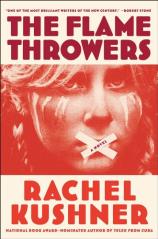The Flamethrowers
Review
The Flamethrowers
Some novels grab you by the throat. Others seduce you with their intelligence and artistry. Rachel Kushner’s THE FLAMETHROWERS, her second novel, is decidedly in the latter category. An intricate examination of art, revolutionary politics and the risks some people are willing to take in life and love, it gains its considerable power through the accretion of closely-observed detail and Kushner’s skill at translating that into alluring prose.
“The two things I loved were drawing and speed,” says Reno, the protagonist and narrator of most of the novel. Her name, after her Nevada home town, is bestowed on her by a man she meets when she arrives, young, friendless and jobless, but with a passion to make art, in New York City in 1975. She’s quickly caught up in the avant-garde art scene and becomes the lover of Sandro Valera, a minimalist sculptor who creates “large aluminum boxes, open on top, empty inside, so bright and gleaming their angles melted together.” Sandro, 14 years her senior, a man who recognizes that “vital life was change and swiftness, which only revealed itself through violent convulsions” seems well-matched to Reno.
"An intricate examination of art, revolutionary politics and the risks some people are willing to take in life and love, it gains its considerable power through the accretion of closely-observed detail and Kushner’s skill at translating that into alluring prose."
Kushner takes some time knitting together the threads of her plot, whose circuitous course and sometime languid pace require an attentive reading. In addition to her passion for art, Reno is a motorcycle racer, and the early chapters of the story find her at the Bonneville Salt Flats, trying to break a land speed record in a vehicle manufactured by the Italian tire company owned by Sandro’s family. She has also come to the site to photograph the tracks of her motorcycle as a piece of conceptual art. The balance of the novel plays out in the territory between these two pursuits, as we learn more of the controversial story of the influential Valera family and Reno’s uncomfortable relationship to it.
By the mid-1970s, when the novel’s main action occurs, the antiwar turmoil of America largely has subsided, but the New York Kushner depicts so vividly is a place teeming with a sense of danger, teetering on the edge of the apocalypse. It’s a city that largely would be unrecognizable to anyone living there today. These are the days before the cleanup of Times Square, when that scene still was blighted by peep shows, prostitutes and drug addicts. Reno is there at the moment the July 1977 blackout hits the city. In flat, chilling prose (“Robbed a Chemical Bank on Delancey Street; firebombed a retailer of Thom McCan Shoes”), Kushner also catalogs the activities of the real life anarchist group, the Motherf***ers, acts of urban terrorism that would be seen in a vastly different light after 9/11. Andy Warhol and Allen Ginsberg appear, at least obliquely, through their connections to some of the novel’s characters, and Kushner’s picture of the times is so realistic one almost expects Patti Smith and Robert Mapplethorpe to join the action.
For a novel that begins with a killing on a World War I battlefield and ends 60 years later with Reno alone in snowy Chamonix, France, Kushner displays an impressive command of her story’s diverse settings and subjects. She excels at extended set pieces, like her account of a left-wing political demonstration that turns violent in Rome or the smart, but often hostile, banter of artists and artistic hangers-on at a SoHo dinner party. Whether she’s describing the harvesting of rubber in a Brazilian jungle or the peculiar mixture of boredom and terror that surrounds the effort to break land speed records in the bleak Utah landscape, Kushner fully inhabits these venues without ever striking a false note.
She is equally skilled at portraying her characters’ inner lives, as she shows Reno waiting to race across the stark desert: "I'd spent half a day among those waiting on death and now I was in line for the long course and hoping I was not the sacrifice." And her snapshots of those characters in action possess a similar bite, as in this glimpse of racer Didi Bombonato: "He flicked his hands into open tens, shut fists, open tens. He jumped up and down in a controlled dribble like a prizefighter." Gems like these sparkle on every page and sustain the pleasure of Kushner's work even when the story's momentum occasionally flags.
Embracing the worlds of motorcycle racing, art and radical politics, THE FLAMETHROWERS sweeps us into the swirl of life amid a memorable group of characters to reveal what it’s like to live on the edge or aspire to do so. “Life,” one of these characters says, “was the one thing to treat as art.” As Kushner does that, there are echoes of both Don DeLillo and Joan Didion, whose concerns and sensibility she seems fully capable of carrying into the next generation of American fiction. This is an audacious novel, one that showcases a brave and talented writer at the top of her game.
Reviewed by Harvey Freedenberg on April 26, 2013
The Flamethrowers
- Publication Date: April 2, 2013
- Genres: Fiction
- Hardcover: 400 pages
- Publisher: Scribner
- ISBN-10: 1439142009
- ISBN-13: 9781439142004











